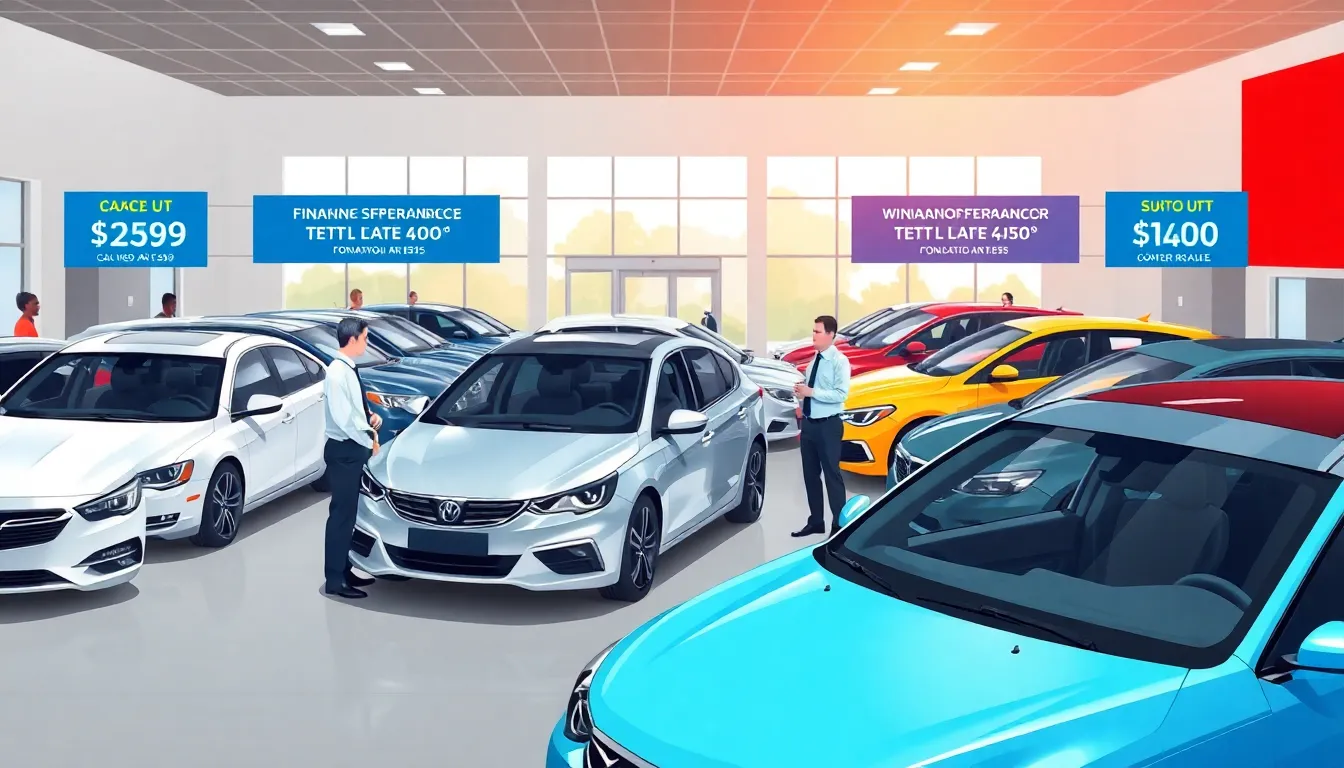
Ever wondered how car dealerships keep their lights on and their lots filled with shiny new rides? It’s not just about selling cars; it’s a whole symphony of revenue streams that would make any accountant do a happy dance. From trade-ins to financing and service departments, these dealerships have mastered the art of turning every interaction into a potential payday.
How Do Car Dealerships Make Money
Car dealerships generate revenue through multiple streams. Vehicle sales represent a primary income source, where dealerships purchase cars from manufacturers and sell them at higher prices. The mark-up ensures profit margins on each transaction.
Financing options also contribute significantly to earnings. Dealerships often partner with banks and other lenders, receiving a commission for arranging loans. This commission can vary based on the loan terms and customer creditworthiness.
Trade-ins play a crucial role in dealership profitability. By accepting customer vehicles as part of the sale, dealerships can recondition and resell these cars, often at a premium. This process not only increases inventory but also reduces upfront costs for customers.
Service departments provide another substantial revenue stream. Routine maintenance, repairs, and parts sales help maximize dealership income. Customers return to the dealership for service due to convenience and trust built during the vehicle purchasing process.
F&I products, like extended warranties and insurance, enhance earnings further. These products protect customers and benefit dealerships through added commissions. Hefty profit margins on these products often boost overall revenue.
Lastly, leasing options attract diverse customers. Dealerships profit from lease payments while retaining ownership of the vehicle. This strategy ensures repeat business when lease terms expire, generating future sales opportunities.
Through these various channels, car dealerships create a robust financial ecosystem focused on maximizing profit while meeting customer needs.
Profit Sources for Car Dealerships

Car dealerships utilize multiple streams to maximize earnings. These revenue sources include vehicle sales, trade-ins, and financing options.
Vehicle Sales
Vehicle sales represent the primary income source for dealerships. Dealerships purchase inventory from manufacturers and apply a markup for resale. They aim to attract customers with competitive pricing while maintaining margins. Limited-time offers on popular models can incentivize sales. Many dealerships optimize their inventory based on market demand, ensuring they stock vehicles that attract buyers. This strategy fosters a quicker turnover of units, enhancing profitability.
Trade-Ins
Trade-ins significantly boost a dealership’s profitability. Customers benefit from using their current vehicle’s value as a credit toward a new purchase. Dealerships then renovate these vehicles, preparing them for resale at a profit. Assessing trade-in value accurately ensures fair deals that encourage customer participation. By increasing inventory without upfront costs, dealerships position themselves for future sales opportunities. Enhancing customer relationships through trade-in programs also promotes trust and repeat business.
Financing Options
Financing options provide an essential avenue for income. Dealerships facilitate loans through partnerships with financial institutions, earning commissions on each arrangement. They offer competitive rates to attract buyers while ensuring profit margins remain intact. Optional add-ons, like gap insurance or vehicle service contracts, augment overall revenue. Streamlined financing processes help customers feel comfortable, increasing conversion rates. By offering customized financing plans, dealerships cater to diverse customer needs, fostering a strong financial ecosystem.
Additional Revenue Streams
Car dealerships rely on various additional revenue streams to enhance profitability and strengthen customer relationships.
Service and Repairs
Service departments become crucial profit centers for dealerships. Routine maintenance, including oil changes and tire rotations, keeps customers returning. Beyond maintenance, repair services for unexpected issues generate substantial revenue. Skilled technicians ensure quality service, fostering customer loyalty and trust. Many dealerships also offer service contracts, allowing customers to prepay for services, which enhances cash flow. Service departments create opportunities for upselling additional parts or services during customer visits, maximizing earnings from each interaction.
Extended Warranties
Extended warranties present an appealing option for many car buyers. Dealerships offer these warranties as a way to provide peace of mind against unexpected repair costs. Markups on these warranties contribute directly to the dealership’s bottom line. Customers often appreciate the added security, seeing extended warranties as an investment in their vehicle. Sales teams effectively highlight the benefits of these products during the sales process, increasing penetration rates. The presence of extended warranty options positions dealerships favorably in the eyes of consumers seeking long-term protection.
Insurance Products
Insurance products represent another valuable source of revenue for car dealerships. Partnerships with insurance providers allow dealerships to offer competitive rates on automotive insurance. These arrangements generate commissions for the dealership with every policy initiated. Customers benefit from the convenience of one-stop shopping for their vehicle needs. Dealerships often promote bundled offers that combine vehicle purchases with insurance, simplifying the buying experience. As a result, the integration of insurance products strengthens customer relationships while further enhancing profits.
Challenges Faced by Car Dealerships
Car dealerships encounter various challenges that impact their profitability. Each obstacle requires effective strategies to maintain a competitive edge.
Market Competition
Intense competition exists among dealerships, influencing pricing and inventory strategies. Many dealerships struggle to differentiate their offerings in crowded markets. Competitors often provide similar vehicles, financing options, and services. Lower prices attract customers, pushing dealerships to adjust their profit margins. Online sales platforms further complicate this landscape, as buyers increasingly explore vehicles from home. Maintaining customer loyalty becomes essential for sustaining sales volume amidst various choices. Adaptation to market trends is crucial for dealerships aiming to retain their share in this fast-paced environment.
Economic Factors
Economic fluctuations significantly affect car dealership performance. Factors such as interest rates, inflation, and unemployment influence consumer purchasing power. Rising interest rates can deter potential buyers from financing vehicles, leading to lower sales. Changes in fuel prices can also steer preferences toward specific vehicle types, affecting inventory turnover. A downturn in the economy typically results in decreased consumer confidence, prompting potential buyers to delay purchase decisions. Dealerships must navigate these economic shifts, adjusting marketing strategies and inventory accordingly to mitigate impacts on sales. Understanding these external factors is essential to maintain profitability in challenging times.
Car dealerships employ a multifaceted approach to generate revenue and sustain profitability. By leveraging vehicle sales trade-ins financing and service departments they create a comprehensive financial ecosystem. Each interaction with customers is strategically designed to maximize earnings while fostering loyalty.
Despite facing challenges like market competition and economic fluctuations dealerships adapt their strategies to thrive. They focus on enhancing customer experiences and meeting diverse needs ensuring long-term success. Through these efforts car dealerships not only drive profits but also build lasting relationships with their clientele.
